Shrubs of the Adirondacks:
Hobblebush (Viburnum lantanoides)
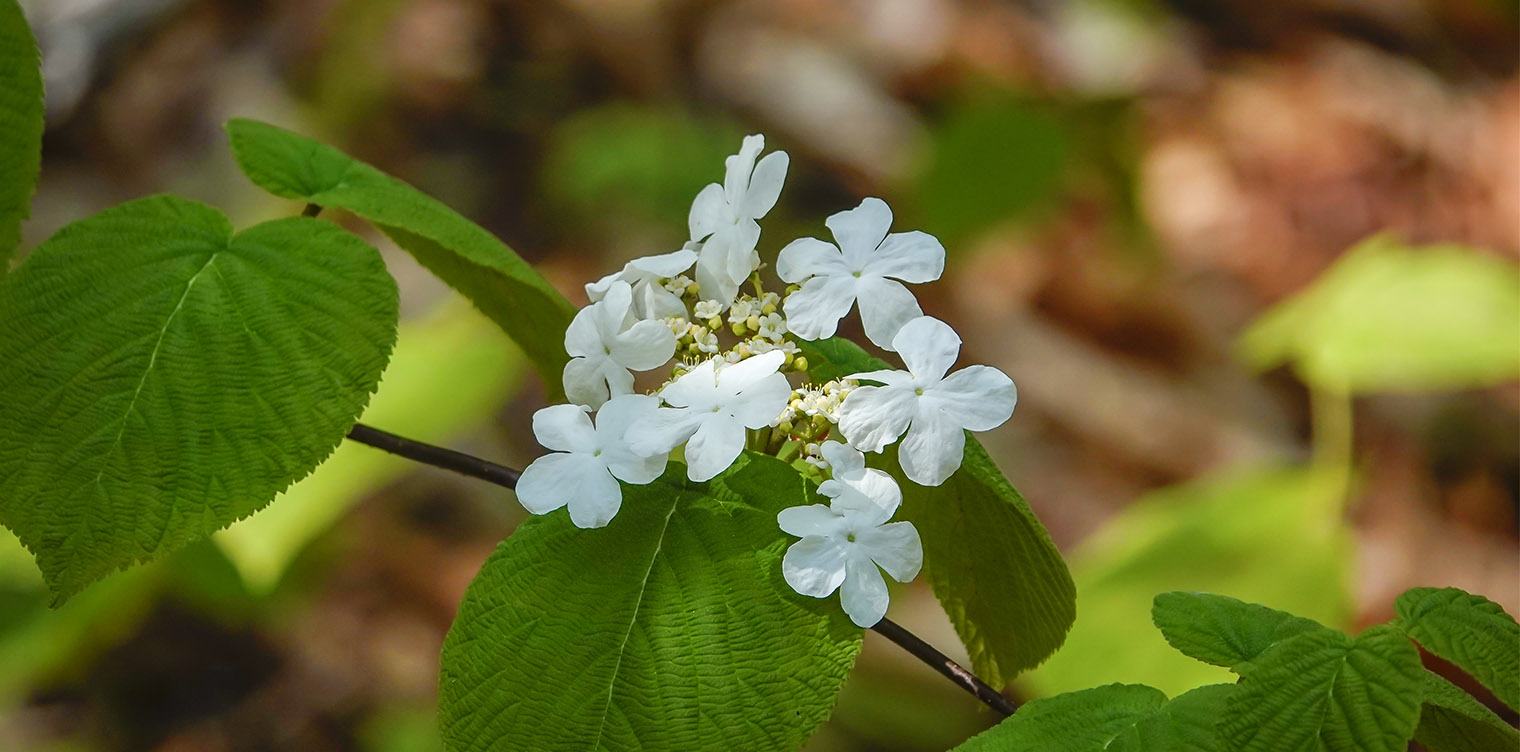
Hobblebush (Viburnum lantanoides) is a native deciduous shrub which abounds in rich, moist woods throughout the Adirondack Mountains. It is one of our most common Adirondack shrubs.
Hobblebush, which was previously classified as a member of the Honeysuckle Family (Caprifoliaceae), is now classified as a member of the Adoxaceae family. The name Hobblebush refers to the fact that the plant has pendulous branches which form obstacles which easily trip (or hobble) walkers. This plant is also known as Hobblebush Viburnum, Witch-Hobble, Moosewood, and Alder-leaved Viburnum. Some field guides list the scientific name of this plant as Viburnum alnifolium. This plant is listed as endangered in Kentucky and New Jersey; Rhode Island categorizes it as a plant of special concern.
Identification of Hobblebush
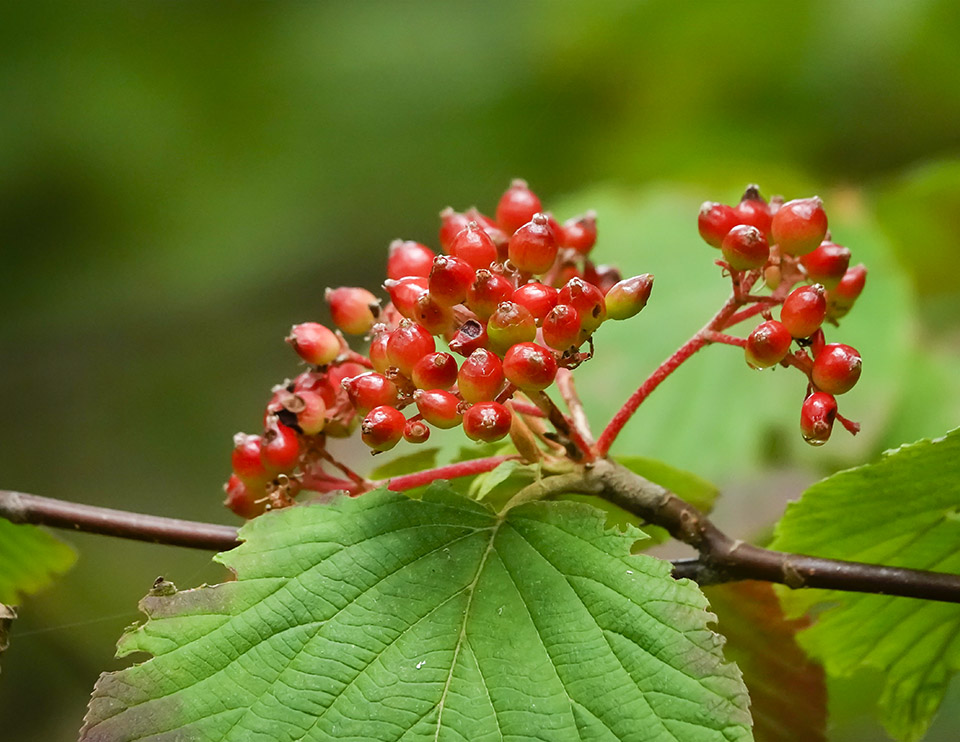
Hobblebush grows three to six feet tall, to a maximum of ten feet. Hobblebush leaves are opposite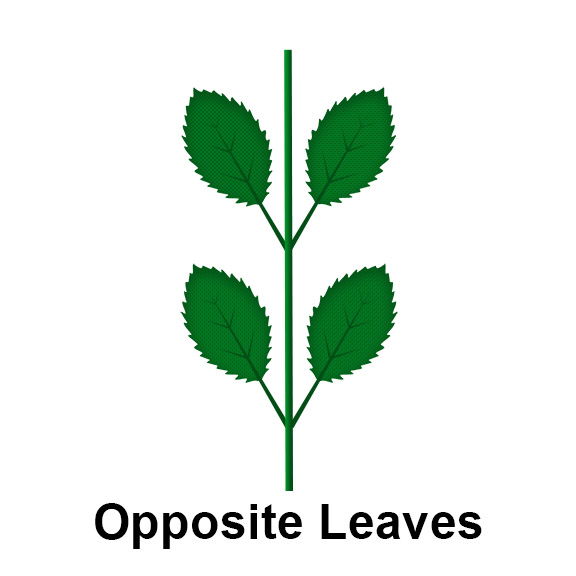 Opposite Leaves: Leaves occurring in pairs at a node, with one leaf on either side of the stem., meaning that there are two leaves per node.
Opposite Leaves: Leaves occurring in pairs at a node, with one leaf on either side of the stem., meaning that there are two leaves per node.
The finely toothed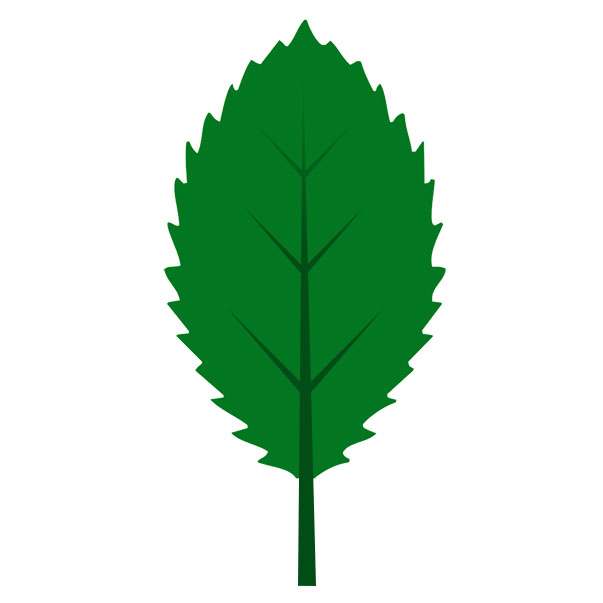 Toothed: Leaves which have a saw-toothed edge. leaves are four to eight inches long, with rather prominent veins; they are heart-shaped at the base, with rounded lobes. The leaves turn bronze-red to purple in the autumn, usually by mid-September in the Adirondack region.
Toothed: Leaves which have a saw-toothed edge. leaves are four to eight inches long, with rather prominent veins; they are heart-shaped at the base, with rounded lobes. The leaves turn bronze-red to purple in the autumn, usually by mid-September in the Adirondack region.
Hobblebush flowers usually appear by mid-May, depending on the weather. The fragrant white flowers are flat-topped clusters 2-6 inches wide. The flowers on the outer edge of each cluster are much larger than those in the middle. The large showy flowers along the edge of the cluster are sterile, while the small greenish inner flowers are fertile.
Hobblebush fruit, which matures in mid-August or September in the Adirondacks, forms a cluster five or six inches wide. The individual fruit is oval, about 1/3 inch long. Scarlet when young, the berries turn deep purple when ripe.
Uses of Hobblebush
The fruit of the Hobblebush reportedly may be eaten raw or cooked and is said to taste somewhat like raisins or dates. Hobblebush has a number of medicinal uses. The Algonquin reportedly rubbed its mashed leaves on the head to treat migraines. Iroquois are said to-have used a decoction of roots as a blood medicine. The plant was also used to treat chest and breathing problems.
Wildlife Value of Hobblebush
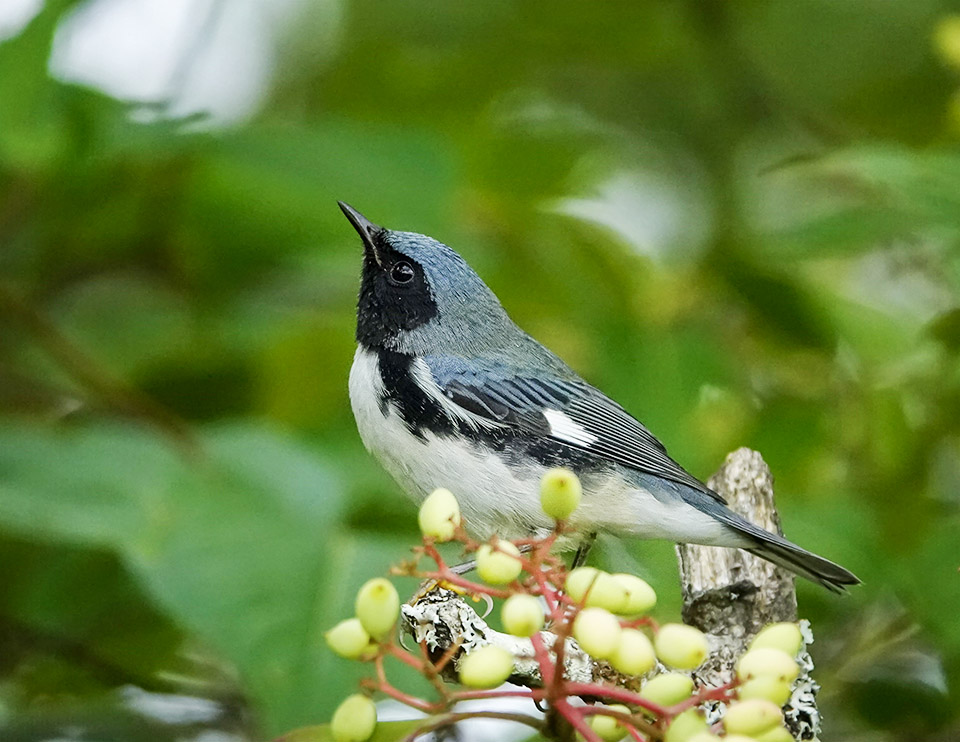
The wildlife value of Hobblebush is moderately high.
- Browsers eat its twigs and leaves. It is a favorite deer browse, especially in winter. According to the New York Department of Environmental Conservation, Hobblebush is one of the preferred or best-liked winter deer foods.
- Game birds, songbirds, and mammals eat the fruit, although it is not taken in great abundance. Birds that feed on the fruit of Hobblebush include Ruffed Grouse, Brown Thrashers, Cedar Waxwings. Mammals which consume Hobblebush fruit include Eastern Chipmunks and Red Squirrels.
- In addition, Hobblebush is a prominent part of the understory in a wide variety of ecological communities in the Adirondacks, including the beech-maple mesic forest. Characteristic breeding birds in such forests include Black-throated Blue Warblers, which sometimes place their nests in Hobblebush.
- Hobblebush is said to be the larval host for the Spring Azure butterfly.
Distribution of Hobblebush
Hobblebush is found in the northeastern portions of the US and Canada. In Canada, its range includes Ontario, Quebec, New Brunswick, Nova Scotia, and Prince Edward Island. In the United State, Hobblebush is found from Maine south to Georgia, Tennessee, and North Carolina. This plant is listed as endangered in Kentucky and New Jersey; Rhode Island categorizes it as a plant of special concern.
Hobblebush is present in most counties in the eastern part of New York State. The species is very common in the cooler parts of the state, including the Adirondacks, where it can form dense thickets. Vouchered specimens of this plant have been reported in all counties within the Adirondack Park Blue Line, with the exception of Clinton County.
Habitat of Hobblebush
Hobblebush is relatively flexible in terms of its soil and site requirements. It is very shade tolerant. It can grow on well or imperfectly drained soils, under either northern hardwoods or spruce-fir.
This species is very common throughout the Adirondack region, often forming the under-story in conifer, northern hardwood, and mixed woods forests. It grows in a wide variety of habitats, including sites in rich, moist woods, by stream banks, and in swamps. It usually occurs in non-wetlands, but can be occasionally found in wetlands.
Hobblebush is found in a number of ecological communities in the Adirondack Park, including:
You can find Hobblebush along virtually all of the trails discussed here. In mixed wood forests, you can find it growing under a mix of conifers and hardwoods, including Sugar Maple, Eastern Hemlock, Red Maple, and Yellow Birch.
- Ground-layer plants include ferns, such as Intermediate Wood Fern and Christmas Ferns. Hay-scented Fern, and New York Fern may be common in canopy gaps.
- Wildflowers commonly found growing near Hobblebush in these ecological communities include Canada Mayflower, Wild Sarsaparilla, Partridgeberry, Common Wood Sorrel, Starflower, and Indian Cucumber-root.
- Birds found in this habitat include the Blue-headed Vireo, Black-throated Green Warbler, and Blackburnian Warbler.
References
Michael Kudish. Adirondack Upland Flora: An Ecological Perspective (Saranac, New York: The Chauncy Press, 1992), pp. 194-195.
New York Flora Association. ew York Flora Atlas. Viburnum lantanoides Michx. Retrieved 8 April 2017.
United States Department of Agriculture. The Plants Database. Hobblebush. Viburnum lantanoides Michx. Retrieved 8 April 2017.
NatureServe Explorer. Online Encyclopedia of Life. Viburnum lantanoides - Michx. Retrieved 8 April 2017.
Northern Forest Atlas. Images. Viburnum lantanoides. Hobblebush. Retrieved 8 April 2017.
Native Plant Trust. Go Botany. Hobblebush. Viburnum lantanoides Michx. Retrieved 18 November 2019.
New York State. Department of Environmental Conservation. New York Natural Heritage Program. Ecological Communities of New York State. Second Edition (March 2014), pp. 119-120, 121, 123, 123-124. Retrieved 17 October 2015.
New York Natural Heritage Program. 2021. Online Conservation Guide for Balsam Flats. Retrieved 11 August 2021.
New York Natural Heritage Program. 2021. Online Conservation Guide for Beech-Maple Mesic Forest. Retrieved 11 August 2021.
New York Natural Heritage Program. 2021. Online Conservation Guide for Hemlock-Hardwood Swamp. Retrieved 11 August 2021.
New York Natural Heritage Program. 2021. Online Conservation Guide for Ice Cave Talus Community. Retrieved 11 August 2021.
New York Natural Heritage Program. 2021. Online Conservation Guide for Mountain Fir Forest. Retrieved 11 August 2021.
New York Natural Heritage Program. 2021. Online Conservation Guide for Mountain Spruce-Fir Forest. Retrieved 11 August 2021.
New York Natural Heritage Program. 2021. Online Conservation Guide for Spruce Flats. Retrieved 11 August 2021.
New York Natural Heritage Program. 2021. Online Conservation Guide for Spruce-Northern Hardwood Forest. Retrieved 11 August 2021.
iNaturalist. Hobblebush. Viburnum lantanoides. Retrieved 11 August 2021.
iNaturalist. Adirondack Park Observations. Hobblebush. Viburnum lantanoides. Retrieved 11 August 2021.
New York State. Adirondack Park Agency. Preliminary List of Species Native Within the Adirondack Park Listed Alphabetically by Scientific Name and Sorted by Habit. Volume 1. Updated 10.23.2006. p. 13. Retrieved 26 January 2017.
Connecticut Botanical Society. Hobblebush. Retrieved 9 April 2017.
Lady Bird Johnson Wildflower Center. Hobblebush. Viburnum lantanoides Michx. Retrieved 8 April 2017.
New York State Department of Environmental Conservation. Winter Deer Foods. Retrieved 9 April 2017.
Donald W. Stokes. The Natural History of Wild Shrubs and Vines. Eastern and Central North America (Harper & Row, Publishers, 1981), pp. 224-230.
Mark J. Twery, et al. Changes in Abundance of Vascular Plants under Varying Silvicultural Systems at the Forest Ecosystem Research and Demonstration Area, Paul Smiths, New York. USDA Forest Service. Research Note NRS-169. Retrieved 22 January 2017, p. 7.
John Eastman. The Book of Forest and Thicket: Trees, Shrubs, and Wildflowers of Eastern North America (Stackpole Books, 1992), pp. 196-197.
Plants for a Future. Viburnum lantanoides - Michx. Retrieved 18 November 2019.
University of Michigan. Native American Ethnobotany. A Database of Foods, Drugs, Dyes and Fibers of Native American Peoples, Derived from Plants. Hobblebush. Viburnum lantanoides Michx. Retrieved 9 April 2017.
National Audubon Society. Field Guide to Wildflowers. Eastern Region. (Alfred A. Knopf, 2001), p. 465.
William K. Chapman, et al. Wildflowers of New York in Color (Syracuse University Press, 1998), pp. 22-23.
William K. Chapman and Alan E. Bessette. Trees and Shrubs of the Adirondacks: A Field Guide (North Country Books, 1990), p. 107.
Anne McGrath. Wildflowers of the Adirondacks (EarthWords, 1981, 2000), p. 6, Plate 3.
Ruth Schottman, Trailside Notes: A Naturalist's Companion to Adirondack Plants (Adirondack Mountain Club, 1998), pp. 126-129.
